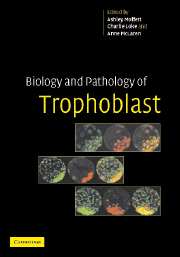Book contents
- Frontmatter
- Contents
- List of contributors
- List of participants
- Preface
- Chair's introduction
- 1 Trophoblast cell fate specification
- 2 Stem cells: pluripotency and extraembryonic differentiation in the mouse
- 3 Epigenetic regulation of trophoblast development
- 4 Regulation of X-chromosome inactivation in relation to lineage allocation in early mouse embryogenesis
- General discussion I
- 5 Gestational trophoblastic disease
- 6 Trophoblast and the first trimester environment
- 7 Implantation is a sticky situation
- 8 Trophoblast regulation of maternal endocrine function and behaviour
- General discussion II
- Final general discussion
- Index
- Plate section
- References
6 - Trophoblast and the first trimester environment
from General discussion I
Published online by Cambridge University Press: 07 August 2009
- Frontmatter
- Contents
- List of contributors
- List of participants
- Preface
- Chair's introduction
- 1 Trophoblast cell fate specification
- 2 Stem cells: pluripotency and extraembryonic differentiation in the mouse
- 3 Epigenetic regulation of trophoblast development
- 4 Regulation of X-chromosome inactivation in relation to lineage allocation in early mouse embryogenesis
- General discussion I
- 5 Gestational trophoblastic disease
- 6 Trophoblast and the first trimester environment
- 7 Implantation is a sticky situation
- 8 Trophoblast regulation of maternal endocrine function and behaviour
- General discussion II
- Final general discussion
- Index
- Plate section
- References
Summary
Introduction
Human early placentation is a difficult topic for systematic research due to ethical constraints, the relative inaccessibility of the tissues and the lack of a suitable animal model, yet events taking place lay the foundation for a successful pregnancy. For many years our knowledge had been reliant upon the interpretation of static images of histological material from pregnant hysterectomy or miscarriage samples. The advent of high-resolution ultrasound imaging in the 1980s provided major new impetus, however, for it enabled events to be followed dynamically in vivo with remarkable clarity. Novel findings using this technique prompted a series of physiological investigations that together have led to a radical reappraisal of the environment in which the feto–placental unit develops. Central to this new appreciation is the premise that the human placenta is not fully haemochorial until the start of the second trimester.
The maternal circulation to the human placenta
During the late secretory phase of the menstrual cycle capillaries arising from the distal segments of the spiral arteries form a plexus within the superficial endometrium that connects with the endometrial veins. When the conceptus implants, the invading syncytiotrophoblastic mantle comes into contact with these capillaries, stimulating them to dilate through endothelial proliferation to form sinusoids, before finally breaking into them (Hertig et al. 1956, Carter 1997). As a result communications are established with the developing lacunae of the trophoblast mantle, the forerunners of the intervillous space, and maternal erythrocytes can be observed in these cavities.
- Type
- Chapter
- Information
- Biology and Pathology of Trophoblast , pp. 111 - 131Publisher: Cambridge University PressPrint publication year: 2006
References
- 2
- Cited by



